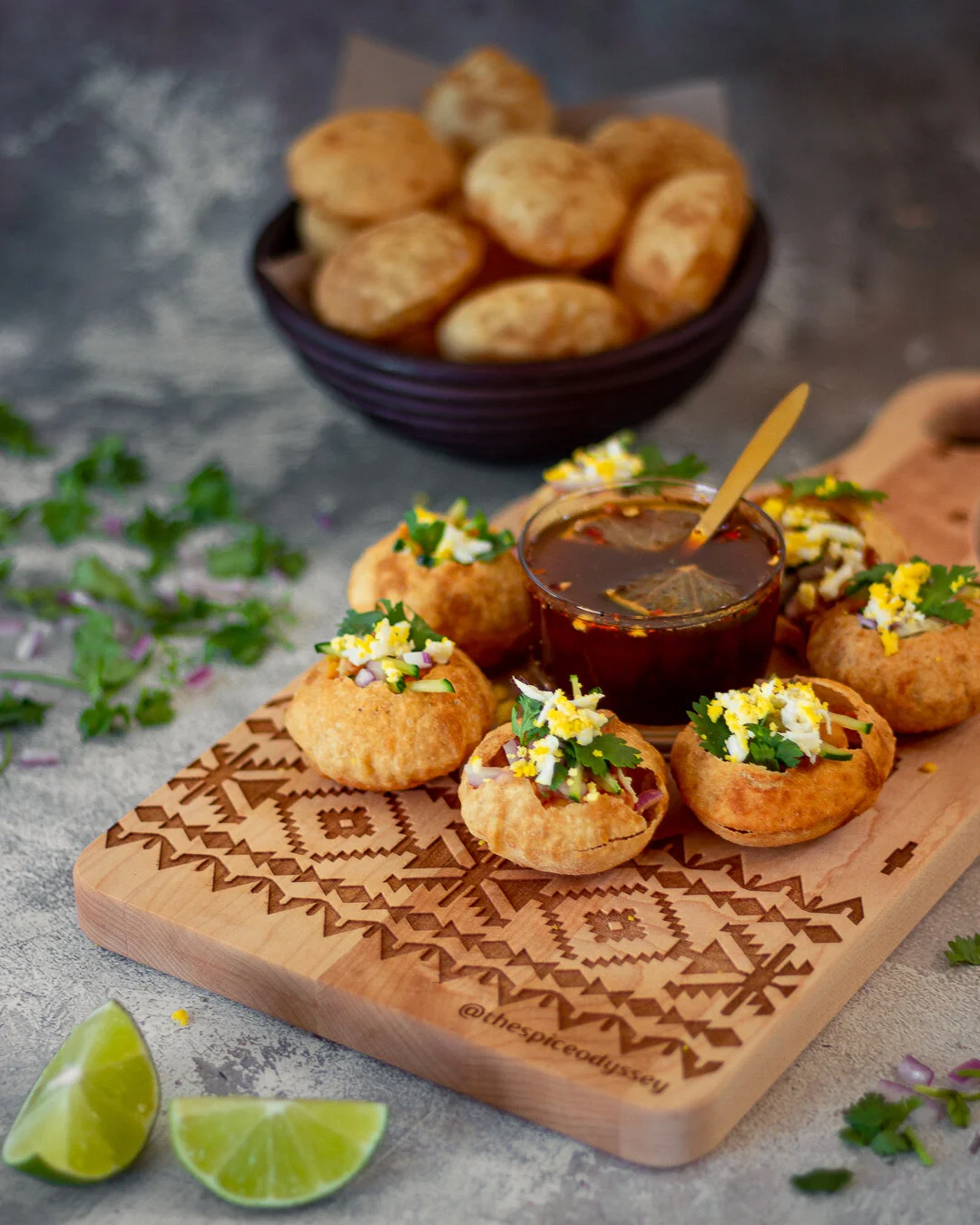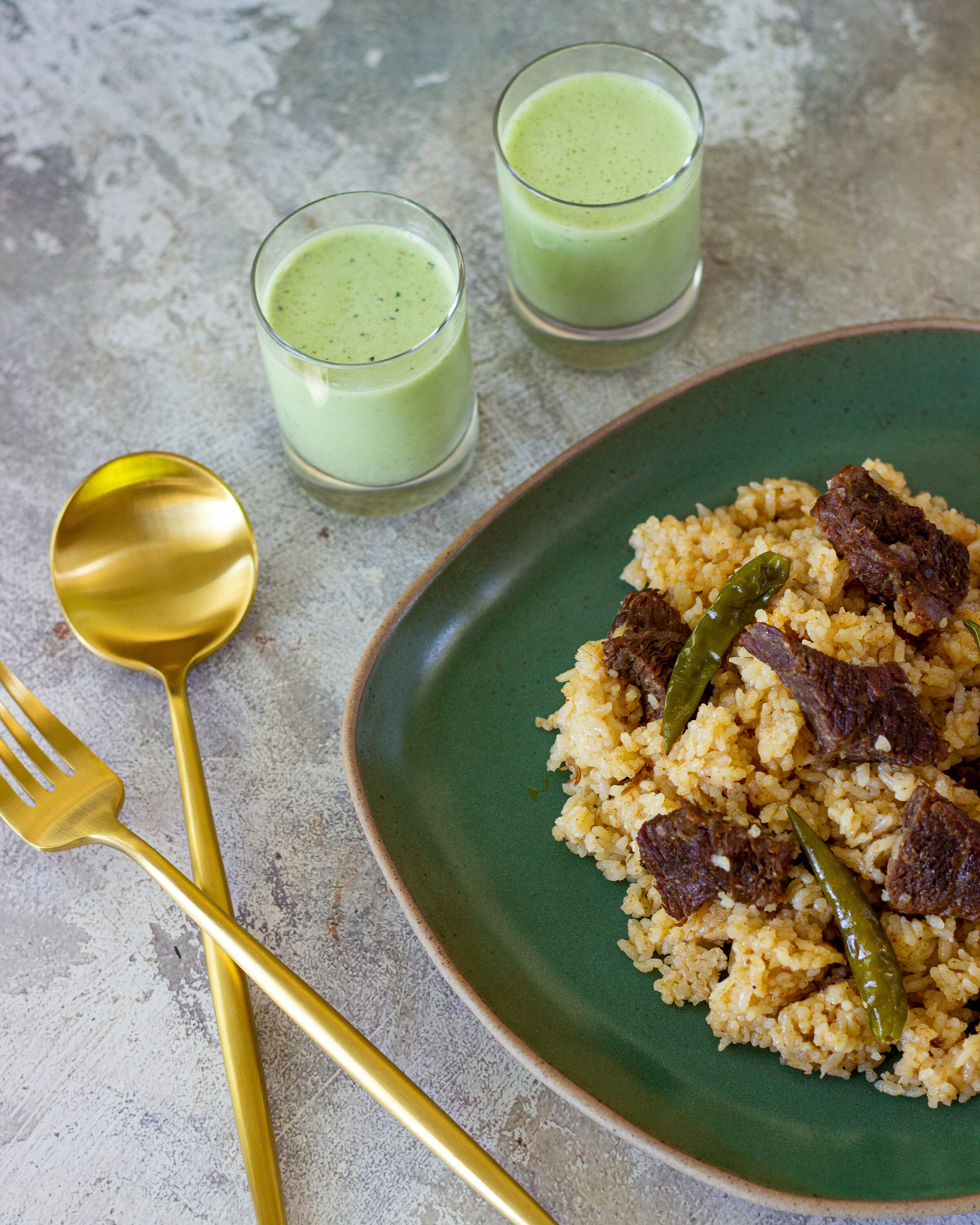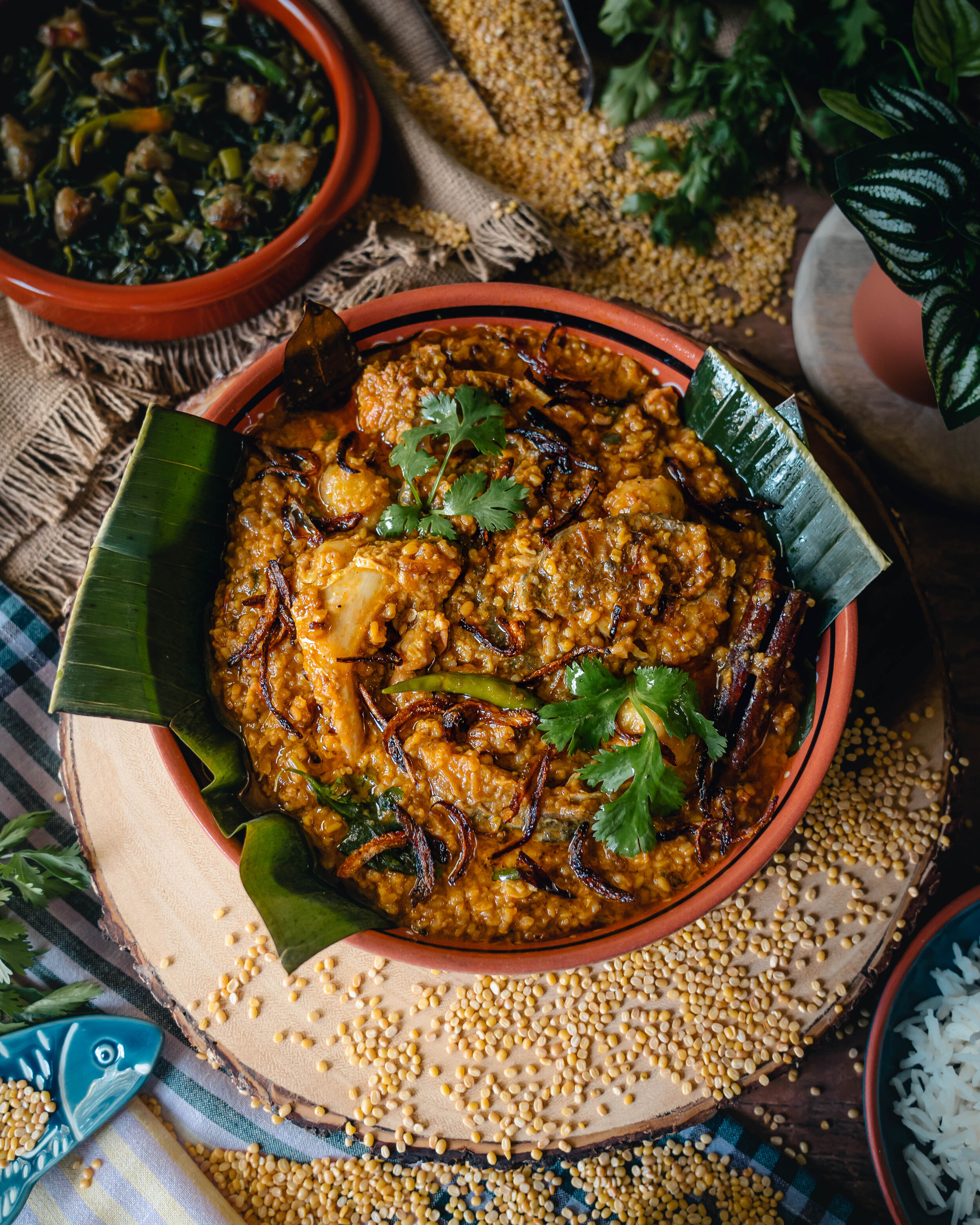Phuchka

There is something comfortingly familiar about eating a phuchka - a crisp fried hollow ball, filled with spicy peas and potatoes, topped with tangy tamarind water, garnished with slivers of onion, cucumber, cilantro and generous helpings of shredded eggs.
To the neophytes, it may sound like culinary chaos but this gastronomic miracle is unarguably one of the greatest culinary inventions of mankind. Phuchka is so delicious that it is “that one dish” unanimously loved by all South Asians. It does go by various different names, aside from phuchka, the two most common names are pani puri and golgappa. Pani puri is the most recognized name in west and south India as well as the rest of the world, while golgappa is more popular in northern India and Pakistan. It’s called phuchka (phooch-kaa) in Bangladesh, Nepal, and eastern Indian states like Jharkhand, West Bengal and Bihar (where it most probably originated). Depending on the region, other names include, paani patashi, pani ke batashe, gup-chup, tikiya, phoolki and pakodi.
Etymology
Let me take it a step further and explain why they are named the way they are. Every name I have listed above denotes to a “watery bread” or a “crisp sphere filled with water”. It’s called “paani puri” because paani means water and puri means deep fried flatbread. People also call it golgappa because the “gol” in the name refers to the circular shape of the snack and “gappa” refers to a mouthful. My favorite which is “phuchka” and of course it has nothing to do with my personal biased judgement for being Bengali. The name “phuchka” comes from the sudden “phuch!” sound when you voraciously bite into this wholesome snack.
Is it Phuchka, Fuchka or Fuska?
It’s all of the above! It all depends on the Bengali dialect you speak and none of them are wrong.
Phuchka - if you speak Shuddho Bangla which derives from Sadhu Bhasha, the formal version of the Bengali language used in professional, academic and legal settings, then Phuchka is the correct term.
Fuchka - if you speak Cholito Bhasha, which is the informal and colloquial versions of Bengali that span across several dialects in Bangladesh, then Fuchka is also accurate.
Fuska - if you speak Sylheti which is the primary language of people spoken in the Sylhet Division of Bangladesh, then Fuska is the correct way of saying it.
The Bangladeshi phuchka, fuchka or fuska does differ from the Indian variations of pani puri or golgappa in its content and taste. Our phuchka shells are slightly bigger in size and much darker in color. Unlike the rest, which has chickpeas or white peas in it’s filling with a side of spicy green mint-coriander water or yellow mango water, phuchka specifically has to have yellow peas in the filling and a red tamarind chutney water that is both spicy and tangy. Regardless of the slight variations, at the end of the day, they are all equally delectable in taste.
How and where did this culinary gem really originate?
It is believed that phoolkis, precursor to the phuchka, first originated in Magadha, one of the sixteen mahajanapadas (great kingdoms in Sanskrit) of ancient India. The Magadhan empire was situated on the banks of River Ganga in what is now west-central Bihar. Lively accounts of Magadh and its capital, Pataliputra, are available in the travel diaries of the Greek historian Megasthenes and the Chinese Buddhist pilgrims Faxian and Xuanzang. During the 6th century BCE, this region played an important role in the development of Jainism and Buddhism and gave rise to two of India’s greatest empires, the Maurya and the Gupta. The Magadha kingdom was an ancient culinary hub from which several modern day delicacies evolved out of. If you are Bengali and you are reading this, you may know of some of them as chira, tiler naru and the most important of them all pitha.
There is another religious folklore associated with the origin of phuchka. In the epic tale Mahabharata, the newlywed bride Draupadi first enters her in-law’s home only to be given a task by her mother-in-law Kunti. I am not joking, that really was the mother-in-law’s name and she was actually a queen. Draupadi, also a princess, was one of the most important female figures in Hindu mythology and wife to the Pandavas, who were five brothers. When the Pandava brothers, Draupadi, and their mother Kunti, were in exile after losing their kingdom in a game of dice, the mother-in-law decided to challenge her daughter-in-law.
Kunti gave Draupadi some leftover potato curry and just enough wheat dough to make one puri, instructing her to make food that would satisfy the hunger of all five of her sons. The reason why she presented this challenge is unconfirmed - some accounts say it was to gauge if Draupadi would be a good housewife who could manage with scarce resources, and others say it was to see if Draupadi would favour one brother over the others. It is believed that this was when the new bride invented phoolki or phuchka in order to earn her mother-in-laws approval and win her over. Impressed with her daughter-in-law’s ingenuity, Kunti blessed the dish with immortality.
While the origins of this delicious snack is yet to be pinpointed with historical accuracy, one thing that is clear is that it travelled across South Asia and made the entire subcontinent fall head over heels in love with it. Phuchka is the most popular street food in Bangladesh and it is a fact certainly not up for debate. Served by roadside vendors all over Dhaka and all other major cities, phuchka gives the word ‘utilitarian’ a run for its money, in every sense, a material manifestation of the elusive emotion called “simple pleasures”. This wholesome street snack is also considered one of the great equalizers – at a phuchka cart, you will see besuited businessmen step out of their shiny cars to join the queue alongside the city’s poorest inhabitants.
Last but not least, actually, the most important question of all.
How do you actually eat a phuchka?
You are to pop the whole thing in your mouth. Close your lips tight. Bite in. Allow the interior of the phuchka to burst and wash over your palate. Savor the piquant, rich and crunchy wonder. Marvel at the interplay of spicy peas and potatoes with the tangy tamarind water. When done right, it can induce eyes to roll to the back of your skull and release involuntary noises from deep within your soul. #ifyouknowyouknow
Now if you want the recipe, scroll down!
Recipe: Phuchka
Serves: a lot, 30-40 puris
Making the Puri
Fine Semolina - 1 cup
AP Flour or Whole Wheat Flour (Atta) - 1/3 cup
Baking powder - 1 tsp
Water - ⅓ - ½ cup
In a large mixing bowl, combine semolina, flour, and baking powder.
Note: It’s important you do not add salt to the phuchka shells if you plan on making a lot and storing them for later. Salt is hygroscopic, meaning it absorbs moisture from the surrounding air. This can affect your phuchka shells by making it flat and stale overtime.
Gradually add ⅓ - ½ cup room temperature water as you are mixing the dough. You may need less than the amount of water I listed so add little by little.
Note: the exact amount of water depends on several factors including how dry or humid the weather is and the altitude of your location which affects the air pressure. I live in California which is higher in elevation and known for really dry and hot summers. If you don’t live in this kind of climate, start with less water, ⅓ cup and add more if needed.
This is going to be a stiff dough. If you don’t have a stand mixer, kneading it is going to be quite the workout. Brace yaselves! I was too lazy to get my stand mixer out because I hate the clean up after. If I can do it, so can you. Knead continuously for 5 minutes. Get Siri or Googoo to set a timer and go at it. Make sure the dough is not too soft and not too hard, just stiff enough. Cover the mixing bowl with a moist kitchen towel and let it rest for at least 30 minutes to an hour.
Note: You have to let the dough rest. Resting dough allows gluten strands to relax a bit and makes it easier to do final shaping.
Divide the dough into quarters. While you work on one quarter, place the rest back in the bowl and keep covered with the moist kitchen towel to prevent them from drying out. Tuck the dough in from all sides to form a tight disc for each dough ball. Lightly flour the surface of the rolling board and rolling pin, then roll the dough ball into a thin long sheet. Make sure the surface is smooth. This step is important. If there are cracks or bumps on the surface, your phuchka shell will not puff up when you fry them. Use a cookie cutter and cut out small round pieces. Repeat the steps above for the other three dough balls.
Frying the Phuchka Shells
Neutral Oil - 1 cup
Heat oil in a wok over high heat.
Note: The oil has to be very, very hot - around 400 F for the shells to puff up. This has to be deep fried so add more oil if you need. The shells will not puff up if you are frying it in shallow oil.
Place each piece on the wok and press down using a perforated spatula. Within a few seconds, it will puff up and rise to the surface. Continue to fry it, basting it with hot oil or turning it over until it is dark golden. Take it out of the oil and place on a cooling rack so that the steam can escape and the shells remain crisp.
Note: If this is your first time, fry each piece one at a time. Take time to fry all the phuchka shells and don't be tempted to put too many in the oil at a time until you have had enough practice. The ones that don’t puff up, save them aside to add then as garnish for your chotpoti! (another recipe for another time).
Making the Tamarind chutney
Tamarind Pulp - 1/2 cup
Water - 4 cups
Grated Jaggery or Brown Sugar - 3 tbsp
Roasted Fennel Powder - 1/2 tsp
Roasted Cumin Powder - 1 tbsp
Roasted Coriander Powder - 1 tbsp
Roasted Red Chilli Powder - 2 tbsp
Roasted Red Chilli Flakes - 1 tsp
Black Salt - 1 tsp
Salt - ½ tsp
Lime Juice - 1 tbsp
In a small saucepan over medium heat, add tamarind pulp, water, grated jaggery and let it come to a boil. Turn down the heat to medium-low and add the roasted powders (fennel, cumin, coriander, red chilli), red chilli flakes, black salt, table salt. Stir well to make sure there are no lumps and everything is dissolved. After 8-10 minutes, once the color has darkened, remove from the heat and add lime juice. Taste test to see if the chutney water is tangy and spicy enough. You may add more spices, salts and lime juice if needed. Let it cool to room temperature before serving. This can be stored in an airtight bottle and refrigerated for up to a month.
Making the Filling
The filling I am making here is called Ghugni in Bengali. Some people confuse it with Chotpoti, but that is more of chaat type appetizer/snack made of white peas or chickpeas and potatoes in a spicy tamarind broth, eaten on it’s own. Ghugni, on the other hand is a dry yellow peas and potato curry used as fillings eaten with puri, phuchka and muri (puffed rice). Essnetially. ghugni and chotpoti are similar to each other but they serve different purposes.
This is a quick and simple ghugni recipe. There are more elaborate versions of ghugni that include more aromatics, spices, lentils and even meat. Since this is a loaded phuchka with eggs and chutney, it’s best to keep the filling more simple.
Yellow Peas (Matar Daal) - 3 cups
Chopped Yellow/White Onions - 1/8 cup
Salt - 2 tsp
Turmeric - 1 tsp
Water - 6 cups
Yukon Gold Potatoes, boiled and chopped - 3
Lime Juice - 1 tsp
Tamarind Chutney - 3 tbsp
Wash and soak the yellow peas overnight. In a dutch oven, add the yellow peas, onions, turmeric, salt and water. Boil over medium heat for as long as you need until the peas are soft and no longer al dente. Turn off the heat, add the boiled potatoes, lime juice, tamarind chutney and mix well. I also like to add some of the garnishes like diced red onion, green chillies and coriander in this mixture as well. It’s optional and totally up to you.
Setting aside the Garnish
Chopped Red Onion - ¼ cup
Chopped Green Chillies - 5-6
Chopped Coriander - ¼ cup
Boiled Eggs, Shredded - 2
Guuuurrk, you know what to do here. Chop em up into bite size pieces.
Serving the Phuchka
Phuchka is assembled one at a time and served and eaten immediately. Use your thumb and gently poke a hole in the middle of the shell. Insert a teaspoon of the peas and potato filling. Pour 1-2 teaspoon of the tamarind water and top it with any or all of the garnish listed above. Stuff it in your mouth and wait for the flavor explosion.








